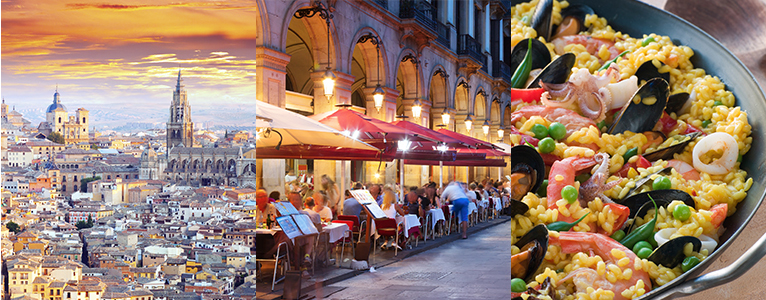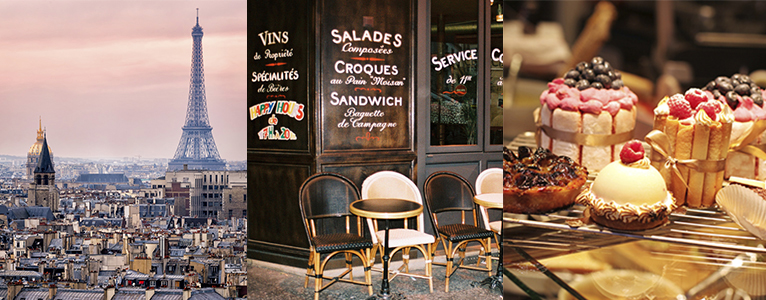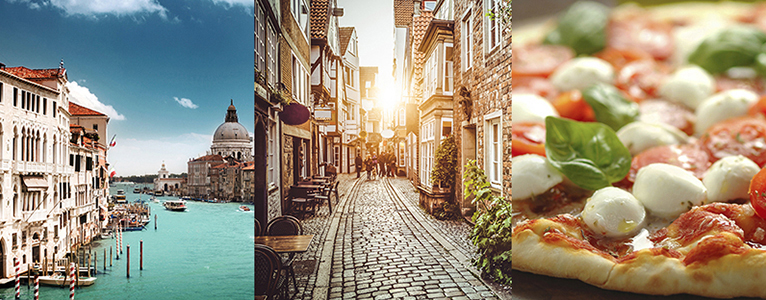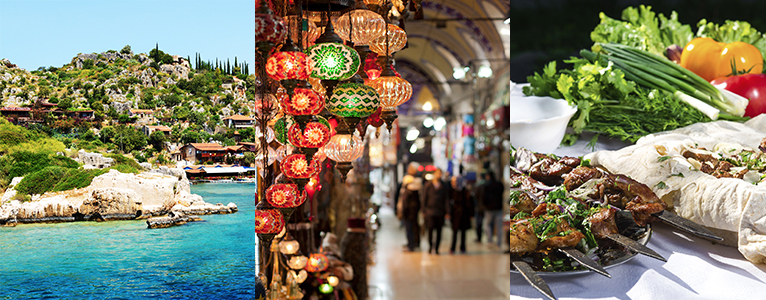
Are you setting your sights on cloudless skies and warmer climates this summer? Summer holidays often promise better weather, long, lazy days, and the opportunity to sample local delicacies and tempting treats.
![]() A concern for many of us might be the types of food and drink available abroad, and these dishes may raise valid questions about just how good they are for the safe management of diabetes.
A concern for many of us might be the types of food and drink available abroad, and these dishes may raise valid questions about just how good they are for the safe management of diabetes.
But, with a bit of planning, you'll find you can enjoy exploring new cuisines on your travels – and you needn’t ditch all your good habits just because you’re going on holiday.
Although we often like to relax our healthy eating habits whilst away, try to remember how it could affect the management of your diabetes.
To help, we're giving you a snapshot of popular foods and dishes from five top European countries – Spain, France, Greece, Italy and Turkey – and help you to understand how to make healthier choices on your travels.
For those who carb count, holidays can mean eating different carb-containing dishes, and snacks that you may be unfamiliar with.
![]() It may be worth reviewing the amount of carbohydrate in foods typical to that country before going away. The carbs and cals app can be a great way of estimating carb content or, if you have a carbs and cals book, taking it with you might make things easier.
It may be worth reviewing the amount of carbohydrate in foods typical to that country before going away. The carbs and cals app can be a great way of estimating carb content or, if you have a carbs and cals book, taking it with you might make things easier.
You may also want to stock up on supplies to monitor your blood sugar more often while you’re away. Getting some advice from your diabetes team before you go could also give you the best chance of keeping your blood sugar in your target range.
Top tips for holiday health
- Make the most of fresh fruit and vegetables. Choose ingredients that are local to the area for maximum flavour.
- Scope out the local supermarket and take healthy snacks and packed lunches with you on day trips and when exploring further afield.
- Try choosing wholegrains – the additional fibre will help to keep you full for longer.
- Think about your choice of ice cream. Look for sugar free alternatives or try natural plain frozen yoghurt with fruit.
- Swap sugary cocktails and beers for spirits with diet mixers.
- Alcohol makes hypos more likely, especially for those on insulin or some Type 2 medications. Avoid alcohol on an empty stomach and have a starchy snack before bed if you do drink.
- Avoid anything fried and stick to baked, grilled or barbecued foods.
- Choose leaner protein like beans, pulses, fish, eggs and lean meat.
- Keep puddings and cakes as a treat.
- Try to be as active as possible – go for a swim, play tennis or simply have an evening stroll after your meal.
See our tips below for tackling the holiday buffet...
Spain

Key words in Spain
Diabetes - diabetes
Diabetic - diabetico
Carbohydrates - carbohidratos
Sugar - azúcar
Blood sugar - glicemia
With its tapas, paella and sangria, there’s a lot of temptation to be had in Spain. A typical paella with chorizo, chicken thighs and seafood can contain 600–700kcal per portion, including 20g fat and 65g carbs. By sticking to a smaller portion, cutting back on high fat ingredients, and topping up the fish content, you can save calories and have a healthier meal. It could also be a good idea to make a three-person serving stretch to feed four. See our paella recipe.
If you’re eating tapas, choose more vegetable, fish and pulse dishes, and try to reduce the amount of cured meats which will be high in calories, saturated fat, and salt. Tapas can make it more difficult to estimate carb content so think about testing your blood sugar levels more often and adjusting insulin doses with prior advice from your diabetes team. Remember, anything in batter is likely to have been fried, and although olive oil is a good source of monounsaturated fat, it still contains a lot of calories. Try balsamic vinegar as a dressing which will also reduce the fat content.
Sangria and red wine are the alcoholic drinks of choice, but bear in mind cocktails can contain added fruit juice with hidden sugars and can mask the strength of the alcohol. A glass of drier wine or spirit and diet mixer can save on calories and sugar.
France

Key words in French
Diabetes – diabete
Diabetic – diabetique
Carbohydrates – hydrate de carbone
Sugar – sucre
Blood sugar – sucre dans le sang
France – home of the croissant, crepe and patisserie. With so much variety, you can easily stack up the sweet treats and sugar intake. Remember, if you have an additional snack during the day and are on multiple daily insulin injections or a pump, you will need to give extra insulin units and test blood sugars more often. A typical day in France might include a pastry for breakfast, a savoury crepe for lunch and another cake or sweet, like macaroons. This little lot can easily add up to over 1000kcals, and that’s before your main evening meal and a glass or two of fizz or brandy. A typical crepe suzette contains 450kcals, 22g fat and 24g sugar. Choosing lighter toppings like fruit can be a healthy choice: our blueberry pancakes provide inspiration. Allowing yourself a treat on holiday is no bad thing, simply try to avoid having all the sweet treats in one day and remember the effect it can have on your diabetes management.
The French also love cheese and are famous for it – Gruyere, brie, Camembert and many others are readily available. A cheese platter, enjoyed with a glass or two of red wine, soon equals lots of calories, fat, and saturated fat. To avoid gaining weight on holiday, choosing lighter choices and low fat soft cheese is one way to help you stay in energy balance.
Greece

Key words in Greek
Diabetes – diavitis
Diabetic – diavitikos
Carbohydrates – ydatanthrakes
Sugar – zachari
Blood sugar – sakcharou sto aima
Typical Greek dishes that spring to mind include kebabs, moussaka, and hummus with a selection of sides for dipping. Sharing a platter with friends can be enjoyable, but also makes it easy to stack up the calories. The selection you choose doesn’t have to hinder your healthy eating goals – chicken kebabs, charred vegetables and olives all offer nutrients that are good for health.
Our recipe for moussaka has a lower fat topping, more veg, and uses lean meat, saving you 400kcals and up to 35g of fat. Greeks love their traditional yogurt and this can be a healthy breakfast choice. Top your yogurt with fruit and avoid adding honey – it’s common in Greece but is no better than table sugar.
The most common drink is ouzo, a strong spirit taken with a splash of water or ice – it’s 100kcal per shot and has a high alcohol content (%). You probably won’t leave Greece without sampling it, but try to sip diet soft drinks or bottled water in between. And, remember that standard measures may not apply in local bars – a shot may be 50–60ml, increasing the calories and amount of alcohol units consumed.
Our Greek-inspired recipes
Italy

Key words in Italian
Diabetes – diabete
Diabetic – diabetico
Carbohydrates – carboidrati
Sugar – zucchero
Blood sugar – glicemia
Pizza, pasta and gelato – the Italian menu is full of our favourite foods. However, there’s also an array of fresh fruit, vegetables, fish, and olive oil to be had. We know that fruit and veg provide lots of vitamins, minerals and fibre, which help to maintain a healthy weight and achieve better blood glucose management. Olive oil is a monounsaturated fat which helps to improve heart health, while oily fish has the added benefit of being rich in omega 3.
Pasta dishes can be made healthier by choosing tomato-based sauces, cutting down on cheese (Italians are lovers of Parmesan), and topping up with extra vegetables and side salads. A typical spaghetti Bolognese can provide 550kcal, 28g fat, 10g saturated fat and 40g carbs. Additional vegetables like peppers and courgettes, with lentils and leaner meats can save you 200kcal, 13g fat, and 8g saturated fat. See our bolognese recipe for inspiration.
Going for thin-based pizzas with vegetable toppings is a better choice. Italians also like to add cream and cheese to pizza, so watch out for extra calories from these added ingredients. The alcohol of choice in Italy tends to be wine, or liquors like limoncello and Marsala. Sweeter dessert wines have more calories and sugar compared with drier wines, and their higher percentage of alcohol means units add up more quickly. As you would at home, try to keep puddings as a treat – only have them if something really takes your fancy. A tiramisu can contain around 450kcal, 30g of fat and 30g of carbs. But, opting for a vanilla gelato could save you up to 300kcal, 20g of fat and 15g of carbs. Of course, there is always fresh fruit in plentiful supply.
Turkey

Key words in Turkish
Diabetes – diyabet
Diabetic – diyabetik
Carbohydrates – karbonhidratlar
Sugar – seker
Blood sugar – kan sekeri
Similar to Greek cuisine, popular Turkish delicacies include lamb, chicken and beef kebabs, mezze-style sharing platters, and rice-based dishes. Locals also love salads and seafood, so there are plenty of healthier options to be had while sampling the warming spices of Turkish cuisine. For those with a sweet tooth, watch out for sugary treats such as baklava and Turkish delight. Available in a wide range of varieties, a single square (a matchbox-sized piece) of baklava generally contains 450kcal and 25g of sugar. As the traditional sweet treat, it’ll be hard to avoid. Turkish delight has less calories at around 50–60kcal per square, but the sugar content is still high at around 13g.
A lamb kebab, with pitta bread and tzatziki-style dressing, can be up to 500kcal, 13g fat and 51g carbs – this depends on the cooking method and the amount of sauce added. Try our donner kebabs and smoky tofu kebabs recipes and save a massive 400kcal by choosing the vegetarian option and ditching the pitta bread.
The Turkish drink of choice is similar to the Greeks – a spirit called Raki that has a high alcohol content (%) and is slightly higher in calories (at 105kcal per shot) than its neighbouring drink Ouzo.
Beat the holiday buffet
Have you booked an all-inclusive holiday? The buffet-style breakfast, dinner, and sometimes lunch, combined with free-flowing alcohol and little extras, can pose difficulties for a healthy diet. With these tips, you can enjoy and indulge in the variety, without compromising your efforts:
- Scope out the options and choose what appeals rather than having a ‘bit of everything’.
- Fill up your plate with a great selection of fresh salads and vegetables.
- There’s usually a soup option for starter – these can be low in calories and will fill you up, reducing temptation for mains and desserts.
- Try something new – there is usually a selection of traditional British dishes on offer, but baked or grilled fish or chicken provides a lighter choice.
- Remember to try and alternate alcoholic drinks with diet or sugar-free soft drinks, and ask for a bottle of water for your table.
- Try using a smaller plate and filling half with vegetables or salad. Choose lean protein and high-fibre carbs.
- Although very tempting, try not to sample every sweet option at once – you’ll enjoy them far more as a treat.
- If you count carbs, the staggered pace of a buffet may require you to adjust the way you administer your insulin doses. Talk to your diabetes team about the best way to manage this.
